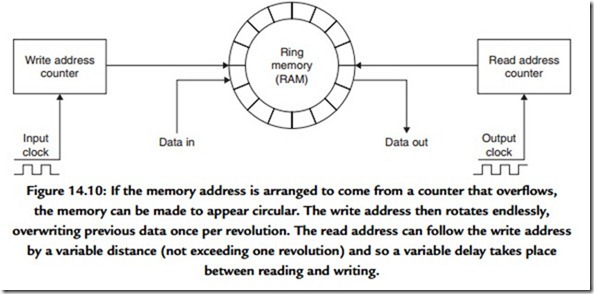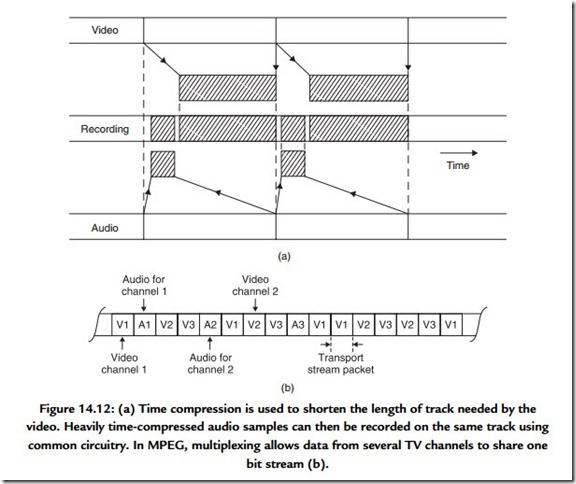Time Compression and Expansion
Data files such as computer programs are simply lists of instructions and have no natural time axis. In contrast, audio and video data are sampled at a fixed rate and need to be presented to the viewer at the same rate. In audiovisual systems the audio also needs to be synchronized to the video. Continuous bit streams at a fixed bit rate are difficult for generic data recording and transmission systems to handle. Such systems mostly work on blocks of data that can be addressed and/or routed individually. The bit rate may be fixed at the design stage at a value that may be too low or too high for the audio or video data to be handled.
The solution is to use time compression or expansion. Figure 14.10 shows a RAM that is addressed by binary counters that periodically overflow to zero and start counting again, giving the RAM a ring structure. If write and read addresses increment at the same speed, the RAM becomes a fixed data delay as the addresses retain a fixed relationship. However, if the read address clock runs at a higher frequency but in bursts, output data are assembled into blocks with spaces in between. Data are now time compressed.
Instead of being an unbroken stream, which is difficult to handle, data are in blocks with convenient pauses in between them. Numerous processes can take place in these pauses. A hard disk might move its heads to another track. In all types of recording and
transmission, the time compression of the samples allows time for synchronizing patterns, subcode, and error-correction words to be inserted.
Subsequently, any time compression can be reversed by time expansion. This requires a second RAM identical to the one shown. Data are written into the RAM in bursts, but read out at the standard sampling rate to restore a continuous bit stream. In a recorder, the time-expansion stage can be combined with the time base correction stage so that speed variations in the medium can be eliminated at the same time. The use of time compression is universal in digital recording and is widely used in transmission. In general the instantaneous data rate in the channel is not the same as the original rate, although clearly the average rate must be the same.
Where the bit rate of the communication path is inadequate, transmission is still possible, but not in real time. Figure 14.11 shows that data to be transmitted will have to be written in real time on a storage device such as a disk drive, and the drive will then transfer data at whatever rate is possible to another drive at the receiver. When the transmission is complete, the second drive can then provide data at the correct bit rate.
In the case where the available bit rate is higher than the correct data rate, the same configuration can be used to copy an audio data file faster than in real time. Another application of time compression is to allow several streams of data to be carried along the same channel in a technique known as multiplexing. Figure 14.12 shows some examples.
In Figure 14.12(a), multiplexing allows audio and video data to be recorded on the same heads in a digital video recorder such as DVC. In Figure 14.12(b), several radio or television channels are multiplexed into one MPEG transport stream.


